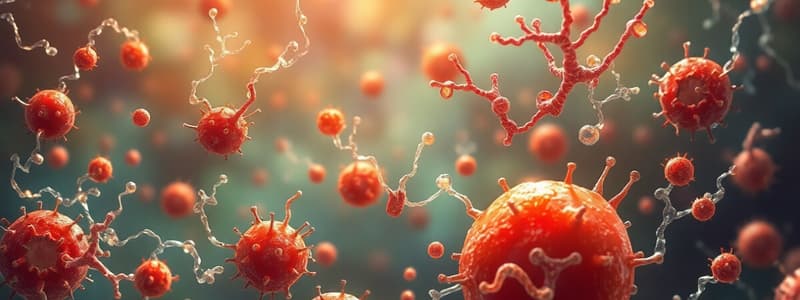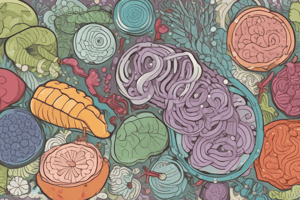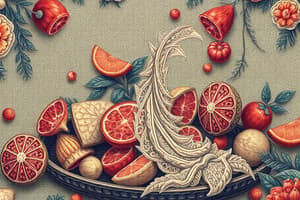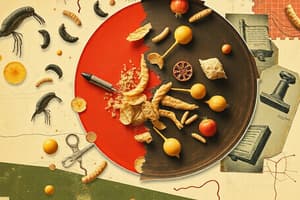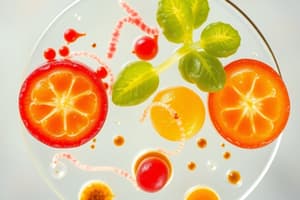Podcast
Questions and Answers
Which of the following is the most accurate definition of food spoilage?
Which of the following is the most accurate definition of food spoilage?
- The presence of pathogenic microorganisms that cause illness in humans.
- A significant reduction in the nutritional value of a food product.
- A change in the organoleptic properties of a food, making it unacceptable. (correct)
- The complete decomposition of a food product due to enzymatic reactions.
All microorganisms present in food are detrimental and cause spoilage.
All microorganisms present in food are detrimental and cause spoilage.
False (B)
What is the specific group of bacteria primarily responsible for the fermentation process in vinegar production?
What is the specific group of bacteria primarily responsible for the fermentation process in vinegar production?
Acetic acid bacteria
The spoilage of food is mainly due to a change in the ______ properties of the food.
The spoilage of food is mainly due to a change in the ______ properties of the food.
Match the following spoilage mechanism with its primary category:
Match the following spoilage mechanism with its primary category:
Which of the following is the most direct consequence of microbial spoilage in food?
Which of the following is the most direct consequence of microbial spoilage in food?
Pasteurization eliminates all microorganisms in food, ensuring indefinite shelf life.
Pasteurization eliminates all microorganisms in food, ensuring indefinite shelf life.
Name three specific conditions that typically promote the growth of spoilage microorganisms in food.
Name three specific conditions that typically promote the growth of spoilage microorganisms in food.
The growth and metabolism of spoilage microorganisms can cause ______ changes in food, affecting its sensory qualities.
The growth and metabolism of spoilage microorganisms can cause ______ changes in food, affecting its sensory qualities.
Match each foodborne pathogen with its primary food source:
Match each foodborne pathogen with its primary food source:
Which of the following best describes the function of starter cultures in food fermentation?
Which of the following best describes the function of starter cultures in food fermentation?
Fermented foods are always safe to consume, regardless of any off-odors or discoloration.
Fermented foods are always safe to consume, regardless of any off-odors or discoloration.
What metabolic byproduct is produced during lactic acid fermentation that contributes to the preservation of fermented foods?
What metabolic byproduct is produced during lactic acid fermentation that contributes to the preservation of fermented foods?
The fermentation of milk by Lactobacillus bulgaricus and Streptococcus thermophilus results in the production of ______.
The fermentation of milk by Lactobacillus bulgaricus and Streptococcus thermophilus results in the production of ______.
Match each fermented food with its primary type of fermentation:
Match each fermented food with its primary type of fermentation:
Which of the following characteristics is most indicative of a food undergoing undesirable microbial spoilage?
Which of the following characteristics is most indicative of a food undergoing undesirable microbial spoilage?
The presence of esters and organic acids in spoiling food indicates that the food is undergoing autolysis.
The presence of esters and organic acids in spoiling food indicates that the food is undergoing autolysis.
Name the spoilage organism that causes muscle weakness, blurred vision and can ultimately lead to death.
Name the spoilage organism that causes muscle weakness, blurred vision and can ultimately lead to death.
Diarrhea, fever, and stomach cramps are the result of the spoilage organism, ______
Diarrhea, fever, and stomach cramps are the result of the spoilage organism, ______
Match the spoilage organism to the food that is often impacted:
Match the spoilage organism to the food that is often impacted:
Flashcards
Food Spoilage
Food Spoilage
Food spoilage is a major cause of food waste due to undesirable microbial activity.
Spoilage Definition
Spoilage Definition
Spoilage is defined as a change in the organoleptic properties of a food, such as taste, smell, texture, or appearance.
Food Pathogens
Food Pathogens
Food pathogens are spoilage organisms that cause illness in humans when consumed.
Salmonella spp
Salmonella spp
Signup and view all the flashcards
Listeria monocytogenes
Listeria monocytogenes
Signup and view all the flashcards
Cyclospora
Cyclospora
Signup and view all the flashcards
Campylobacter
Campylobacter
Signup and view all the flashcards
E. coli
E. coli
Signup and view all the flashcards
C. botulinum
C. botulinum
Signup and view all the flashcards
Beer
Beer
Signup and view all the flashcards
Wine
Wine
Signup and view all the flashcards
Yogurt
Yogurt
Signup and view all the flashcards
Kefir
Kefir
Signup and view all the flashcards
Vinegar
Vinegar
Signup and view all the flashcards
Sauerkraut
Sauerkraut
Signup and view all the flashcards
Kimchi
Kimchi
Signup and view all the flashcards
Study Notes
- Undesirable microorganisms cause food spoilage
Food Spoilage
- Spoilage leads to food waste
- Spoilage is a change in the organoleptic properties of food
- Microbes cause spoilage by growing on food and producing organic acids, esters, carbonyls, diamines, sulfur compounds, hydrocarbons, and pigments
- Microbial growth can also cause changes in the appearance of colonies and texture
Food Pathogens
- Food pathogens are pathogenic spoilage organisms that cause illness in humans
- Salmonella spp. in vegetables, eggs, chicken, and pork cause diarrhea, fever, stomach cramps, and vomiting
- Listeria monocytogenes in unpasteurized milk and dairy, deli meat, raw fruits, and vegetables causes stiff neck, confusion, fever, and muscle aches, and can cause stillbirths in pregnant women, if it spreads beyond the gut
- Cyclospora in raspberries, basil, cilantro, snow peas, and mesclun lettuce causes diarrhea, loss of appetite, weight loss, stomach cramps/pain, bloating, increased gas, nausea, and fatigue with a one week incubation period
- Campylobacter in unpasteurized milk, chicken, shellfish, turkey, and water causes diarrhea, cramps, fever, and vomiting
- E. coli in contaminated, undercooked beef, milk, raw fruits, and vegetables causes severe diarrhea and stomach pain
- C. botulinum in improperly canned foods and honey in infants causes muscle weakness, blurred vision, and can result in death
Useful Microorganisms in Food
- Some fermented foods rely on microorganisms for preservation
- Examples of fermented foods are beer, wine, yogurt, kefir, vinegar, sauerkraut, and kimchi
Beer
- Beer is brewed from grains like barley and hops
- Beer flavors range from light and crisp to dark and malty
- Beer's brewing process is similar to cooking, allowing for ingredient and spice additions
- Beer contains protein, fiber, B vitamins, folate, and niacin, offering a food-like nutritional value
- Beer generally has lower alcohol content compared to wine
- A standard serving of beer has about the same amount of alcohol as a standard glass of wine and is generally cheaper than wine
Wine
- Wine is made from fermented grapes
- Wine has a more acidic and fruity taste profile
- Flavor varies depending on the grape variety, aging, and winemaking techniques
- Red wine contains antioxidants, particularly flavonoids and tannins, that contribute to heart health
- Wine typically has a higher alcohol and energy content than beer
Yogurt
- Yogurt cultures primarily contain Lactobacillus bulgaricus and Streptococcus thermophilus
- Yogurt is fermented using yogurt starter cultures, which are typically bacteria
- Yogurt is milder and sweeter, with a thicker, spoonable consistency; it is thicker and more solid than kefir
Kefir
- Kefir contains a wider variety of bacteria and yeasts, including Lactobacillus kefiri, Saccharomyces cerevisiae, and Saccharomyces unisporus
- Kefir is fermented using kefir grains, forming a symbiotic culture of bacteria and yeast
- Kefir is tangier and slightly sourer, with a thinner, more drinkable consistency; it is thinner and more liquid-like than yogurt
Sauerkraut
- Sauerkraut is made primarily from cabbage, salt, and sometimes caraway seeds
- Sauerkraut tastes tangy and sour
- Sauerkraut ferments for a longer time than kimchi, and is typically shredded
Kimchi
- Kimchi uses a wide variety of vegetables and spices
- Ingredients include napa cabbage, radishes, cucumbers, gochugaru chili powder, garlic, and ginger
- Kimchi can be spicy, salty, and tangy, depending on the ingredients and fermentation time
- Kimchi is served in larger chunks compared to sauerkraut
Studying That Suits You
Use AI to generate personalized quizzes and flashcards to suit your learning preferences.
